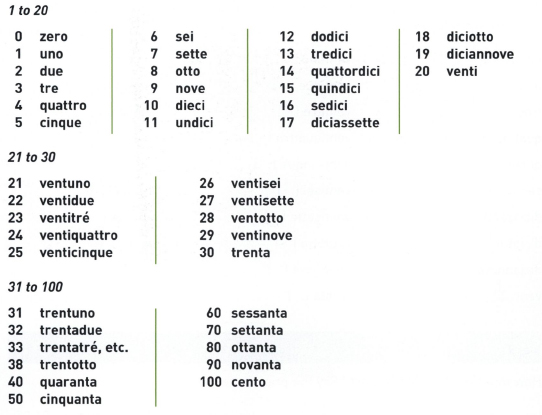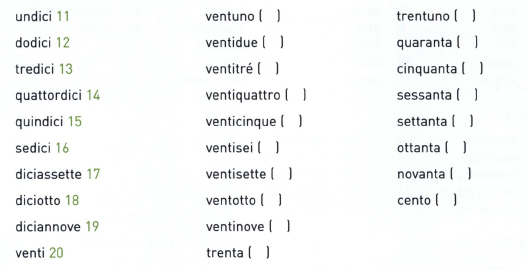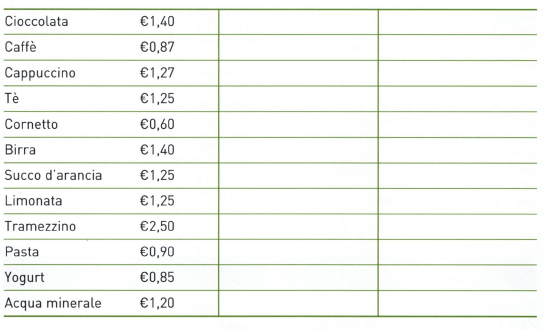 1 Look who’s talking
1 Look who’s talkingUnit 1
Ciao, mi chiamo…
FUNCTIONS |
|
|
• Meeting people, introducing oneself and others |
|
• Formal (Lei) or informal (tu) ‘you’ |
|
• Indicating nationality |
|
• Asking for something, ordering food and drink |
GRAMMAR |
• Present tense of essere and chiamarsi |
|
• Nouns (singular) |
|
• Indefinite articles un, uno, una, un’ |
|
• Subject pronouns io, tu, lui, lei, Lei, noi, voi, loro |
|
• Adjectives of nationality inglese, italiano (singular form only) |
VOCABULARY |
• Greetings |
|
• Nationality |
|
• Food, drink |
|
• Numbers 1–100 |
|
• Euros |
 1 Look who’s talking
1 Look who’s talking
Listen to these people introducing themselves (Audio 1.1) and number them as you hear them. The first one is done for you.
( ) Ciao sono Enza! |
( ) Buongiorno, mi chiamo Luigi Ferretti, e Lei? |
( ) Piacere, sono Paola! |
(1) Buonasera, sono Giovanni Ruggeri. |
( ) Piacere, io sono Emilio Passerini |
( ) Ciao, mi chiamo Elena, e tu? |
( ) Ah, Giovanni, che piacere … sono la mamma di Luisa! |
( ) lo sono Caterina, piacere! |
 2 Match the conversations
2 Match the conversations
After listening to the conversations (Audio 1.1) again, sort them into four pairs so that the brief conversations make sense. The first pair is done for you.
(1) Buonasera, sono Giovanni Ruggeri.
(8) Ah, Giovanni, che piacere … sono la mamma di Luisa!
 3 Introduce yourself
3 Introduce yourself
Now you try. Introduce yourself as in the examples above, using the prompts below.
1 Ciao, sono Giulia. (Paola) 
 Piacere, sono Paola.
Piacere, sono Paola.
2 Buongiorno, mi chiamo Enrico Rossi. (Mario Ferri) ________________________
3 Buonasera, sono Simona. (Giovanni) ____________________________________
4 Ciao, mi chiamo Carola, e tu? (Cinzia) __________________________________
5 Buongiorno, sono Federico Rovereti, e Lei? (Carlo Bosi) ____________________
 4 Where are they from?
4 Where are they from?
Look at the map and match each nationality to the right place by placing the number on the country you think it belongs to. The first one is done for you.

GRAMMAR NOTES I
Lei or tu?
Italian has two ways of saying ‘you’: the formal or Lei form and the informal or tu form. Use the tu form when speaking to people you know well or children, but use Lei with older people or people you have just met. The verb used with Lei has the same form as lui ‘he’ and lei ‘she’.
Chiamarsi, essere
Enza, Luigi and friends introduce themselves in two different ways: using chiamarsi (to be called) and essere (to be):
Come ti chiami (tu)? |
Mi chiamo Elena. Ciao, sono Paola! |
|
lo sono Caterina, piacere! |
We don’t have to use the pronouns io, tu, Lei, etc. because the verb forms tell us who is being referred to, so we have put them in brackets in the verb list below.
Sometimes when using the polite form, we do use the pronoun Lei to make the question sound less abrupt:
Come si chiama (Lei)? |
Mi chiamo Luigi. Piacere, io sono Emilio Passerini. |
Chiamarsi ‘to call oneself’ is a reflexive verb (see Unit 5), a verb which refers to oneself: literally mi chiamo means ‘I call myself’, si chiama means ‘he calls himself’ or ‘she calls herself’ and so on. (For the forms of -are verbs see Unit 2.)
Chiamarsi

Essere to be’ is an irregular verb; it doesn’t follow the pattern of other verbs.
Essere

Ciao, piacere, buongiorno, buona sera
Younger speakers in an informal context use ciao amongst themselves, to say hello or goodbye. In a more formal situation, however, you would normally use piacere when introduced. When meeting or saying goodbye to both old and new friends, you can use buongiorno or buona sera. Buona notte is only used when going home at the end of the evening or going to bed.
Adjectives (aggettivi)
There are two main types of adjectives in Italian.
One group of adjectives ends in -o/-a depending on whether the person/object described is masculine or feminine. These include italiano, tedesco, americano, russo, spagnolo, svizzero:
Luciano Pavarotti è italiano. |
Barbra Streisand è americana. |
Il giornale Herald Tribune è americano. |
La Alfa Romeo è italiana. |
The other group of adjectives ends in -e. It includes inglese, francese, svedese, scozzese, irlandese, giapponese, canadese. The ending remains the same whether the person or object is masculine or feminine.
Tony Blair è inglese. |
Queen Elizabeth è inglese. |
Il televisore è giapponese. |
La Toyota è giapponese. |
Adjectives in Italian normally come after the noun:
un cornetto dolce |
a sweet croissant |
una birra ghiacciata |
an ice-cold beer |
Some very common adjectives normally go before the noun. These include:

These adjectives can also come after the noun to emphasise that particular quality. Sometimes the change of position gives them a different meaning.
un grande uomo |
a great man |
un uomo grande |
a big man |
The plural forms of adjectives are covered in Unit 2.
Numbers 1–100

The i is dropped from venti when combined with numbers starting with a vowel e.g. uno, otto so it becomes ventuno, ventotto.
Tre does not have an accent on the last letter but compound numbers which include tre do, e.g. ventitré, trentatré.
The a is dropped from trenta when combined with numbers starting with a vowel, e.g. in trentuno, trentotto; the same applies to all the other numbers ending in -a.
Euros
The unit of currency in Italy – as in most other EU countries – is the euro (€). Many older people still count in Italian lire. The euro is approximately the equivalent of 2000 old Italian lire, so cinque euro ‘five euros’ are worth 10,000 lire, and so on. The euro is divided into centesimi ‘cents’ and prices are shown in both:
€1,47 = 1 euro 47 centesimi
€2,00 = 2 euro
 5 Write and say the numbers
5 Write and say the numbers
Write the corresponding number under each word and say them out loud. The first two rows are done for you.

 6 Prices
6 Prices
How much do these items cost? Say the price in Italian.

 7 What nationality are they?
7 What nationality are they?
Fill in the gaps with the right nationalities from the list in Exercise 4, as in the example.
Example
Luciano Pavarotti è italiano.

 8 The cinema game!
8 The cinema game!
Now let’s try to guess the nationalities of the stars mentioned below. Carry out a role play with your partner and exchange the information you have, following the model shown below. Each of you has certain information you know already (in part 1) and some information you want to find out from your partner (in part 2). (Student B’s part is found at the end of the unit.)
Example
Student A: |
Sophia Loren è francese? |
Student B: |
No, è italiana. Neil Jordan è inglese? |
Student A: |
No, è irlandese. |
Student A
Part 1: Information you have

Part 2: Information you need

 9 Pleased to meet you!
9 Pleased to meet you!
Make up some dialogues, using the prompts below, and act them out with your partner.
Example
Roberto (italiano) 
 John (inglese)
John (inglese)
A: Ciao, sono Roberto. Sono italiano.
B: Piacere, io mi chiamo John. Sono inglese.
1 Maurizia Domini (italiana) 
 Jean Pierre (francese)
Jean Pierre (francese)
2 Beth Springfield (americana) 
 Gunter Kaun (tedesco)
Gunter Kaun (tedesco)
3 Manolo (spagnolo) 
 Patrizia (italiana)
Patrizia (italiana)
4 Marc McManus (irlandese) 
 Katsushi Imai (giapponese)
Katsushi Imai (giapponese)
5 Irma (spagnola) 
 Chris (americano)
Chris (americano)
 10 Ciao, mi chiamo Giovanni …
10 Ciao, mi chiamo Giovanni …
Example
Mi chiamo Giovanni, sono italiano di Napoli.
Write your own personal introduction, based on the example above, saying your name, nationality and where you are from.
 11 Al bar
11 Al bar
Read the passage about cafés in Italy (Text 1.1) then answer in English the questions that follow.
Text 1.1 Al bar
In Italia ci sono molti bar. Le persone vanno al bar la mattina per fare colazione. La colazione tipica degli italiani è un cappuccino e un cornetto. Ma gli italiani vanno al bar anche durante il resto della giornata. Dopopranzo prendono un buon caffè o un digestivo, il pomeriggio una cioccolata calda o un tè e prima di cena prendono un aperitivo. Al bar molto spesso gli italiani stanno in piedi. Pagano prima alla cassa dove ricevono lo scontrino. Con lo scontrino vanno al bancone, dove mangiano e bevono. I turisti si mettono seduti ai tavolini, fuori all’aperto se il tempo è bello, ed ordinano direttamente al cameriere. Questo servizio è più costoso, ma anche più comodo!

1 What do Italians drink after lunch?
2 What do they have before dinner?
3 What do you receive at the till?
4 What do you do with this?
5 At the café, where do tourists usually drink and eat?
6 What are the advantages and disadvantages of sitting at a table?
 12 Matching game
12 Matching game
Match the pictures with the right words by drawing a line linking them. The first one is done for you.

 13 What are they ordering?
13 What are they ordering?
Listen to the five dialogues (Audio 1.2-1.6) and write down what people order.
Dialogo 1.2: |
|
Dialogo 1.3: |
|
Dialogo 1.4: |
|
Dialogo 1.5: |
|
Dialogo 1.6: |
|
 14 Put the orders in order!
14 Put the orders in order!
A group of tourists has arrived at Giovanni’s Bar. Listen to the orders (Audio 1.7) and put them in order, numbering them 1–7. The first one is done for you.


 15 Da uno a dieci
15 Da uno a dieci
Let’s count from one to ten.
Uno ____ ____ quattro ____ ____ sette ____ ____
Now let’s try counting in tens, from twenty to one hundred.
Venti ____ ____ ____ ____ ____ ____ ____ _____ cento.
 16 How much does it cost?
16 How much does it cost?
You are in Italy with a very tight budget. Listen to the prices (Audio 1.8) and write them down before ordering. The first one is done for you!

 17 Fill in the gaps
17 Fill in the gaps
Now listen to this new dialogue (Audio 1.9) and fill in the gaps. ‘W’ is the waiter, while A and B are the customers.
W: |
Buongiorno. Desidera? |
A: |
Vorrei un cappuccino e un _______________ |
W: |
E Lei, signore, cosa prende? |
B: |
Una birra _______________ e un tramezzino ____________ |
W: |
Altro? |
A: |
No, grazie. Quant’è? |
W: |
Allora … una birra, un tramezzino … un cappuccino e un cornetto |
|
_____________ euro. |
A: |
_____________ a Lei. |
W: |
Grazie, buongiorno. |
GRAMEER NOTES II
Nouns and indefinite articles
Did you notice how the indefinite article un, una ‘a’ changes? It depends on whether the noun (person or object) is masculine or feminine, singular or plural and also on the letter it starts with. Here’s the pattern below.
• Words ending in -o are (usually) masculine; words ending in -a are (usually) feminine. Words ending in -e are trickier: some are masculine, some are feminine.
• Masculine words use the indefinite article un ‘a’ but uno before nouns beginning with gn, pn, ps, s + a consonant, x, z and the semi-vowel y (j, ie).
• Feminine words use una but un’ before words beginning with a vowel.
• More information on nouns is found in Unit 3.
Masculine |
Feminine |
un cappuccino |
una birra |
un caffè |
una brioche |
un albergo |
un’aranciata |
uno spuntino |
un’automobile |
uno yogurt |
una spremuta |
And this is what normally happens in the plural.
Masculine nouns ending in -o
un cappuccino |
due cappuccini |
uno spuntino |
due spuntini |
Feminine nouns ending in -a
una birra |
due birre |
un’aranciata |
due aranciate |
una spremuta |
due spremute |
Masculine or feminine nouns ending in -e
un’automobile |
due automobili |
un giornale |
due giornali |
Some nouns – especially those of foreign origin and those with the accent on the final syllable – have the same form in the plural as in the singular.
un caffé |
due caffé |
una brioche |
due brioche |
una città |
due città |
un’università |
due università |
 18 Balloon race: un, una, uno
18 Balloon race: un, una, uno
You can certainly recognise the Italian words listed below. Let’s see whether you can put them in the right balloon. The first one is done for you.

 19 Order two of everything
19 Order two of everything
You are terribly hungry! Order two of everything.
Example
Una cioccolata? No, due cioccolate.
un cappuccino? |
un’acqua? |
un caffè? |
uno yogurt? |
una birra? |
un’aranciata? |
un cornetto? |
una lasagna? |
un tè? |
un vino? |
una limonata? |
un minestrone? |
una pasta? |
una ciabatta? |
un tramezzino? |
|
 20 Find the opposite!
20 Find the opposite!
For each word in the list, find the opposite.
caldo |
bollente |
ghiacciato |
freddo |
dolce |
tiepido |
fresco |
salato |
 21 Add the adjectives
21 Add the adjectives
Complete the dialogues with the appropriate adjectives from those given in Activity 20. Make sure the adjectives agree with the nouns.
A: |
Signore, desidera? |
B: |
Vorrei un caffè. |
A: |
_______________ (1) o _____________ (2)? |
B: |
Caldo. |
A: |
E per la signora? |
C: |
Una birra ________________ (3). |
A: |
Per Lei? |
B: |
Vorrei un tramezzino ____________ (4). |
A: |
Subito! |
A: |
Desidera? |
B: |
Un cornetto ____________ (5) ed un’acqua minerale _____________ (6). |
A: |
Desidera, signora? |
B: |
Per me un tè _______________ (7) ed una pasta. |
A: |
Altro? |
B: |
Si, grazie, una limonata _______________ (8). |
 22 Spot the mistakes!
22 Spot the mistakes!
Giovanni is very absent-minded! When he writes down his customers’ orders, he often makes mistakes! Spot the mistakes in this order and correct them.
un cappuccino salato |
una birra bollente |
|
un tramezzino dolce |
un caffè freddo |
|
un cornetto ghiacciato |
|
 23 Fill in the missing adjectives
23 Fill in the missing adjectives
Complete the table, showing which adjective (use the list in Exercise 20) can be used for which item. The items of food or drink can have more than one suitable adjective; list both of them, one in each column. Make sure the adjectives agree.
Example
Cappuccino caldo bollente

 24 Role play
24 Role play
Now work in pairs ordering things from the list above, using the prices shown. Make up a dialogue based on the one below (B = barista; C = client).
B: |
Buongiorno. Desidera? |
C: |
Un caffè. |
B: |
Un caffè? Sono 1 euro e 87 centesimi. |
C: |
Ecco a Lei. |
KEY VOCABULARY
Acqua minerale (f.)
Mineral water can be liscia ‘still’ – also known as naturale – or gassata sparkling’.
Aranciata (f.)
Orangeade, normally in a bottle. Orange juice is (un) succo d’arancia while freshly squeezed orange juice is called (una) spremuta d’arancia.
Barista (m.)
The person serving behind the counter in the bar (café), traditionally male (il barista). Now sometimes women are allowed to make coffee as well.
Caffè (m.), Cappuccino (m.)
If you ask for un caffè you will get an espresso coffee. If you want something more diluted, ask for un cappuccino. Most Italians however only drink cappuccino up to around 11.00 in the morning. After meals, most people drink un caffè. If you want a little bit of milk in your espresso, ask for un macchiato.
Cioccolata (f.), Cioccolato (m.)
A cup of hot chocolate is una cioccolata while the masculine form un cioccolato is normally used for chocolate to eat.
Pasta (f.)
Una pasta or una pastina means an individual cake, as compared to una torta or un dolce which is a large cake shared by everyone. Fresh homemade cakes are sold at la pasticceria or il bar-pasticceria. Each region has its own specialities, for example Naples has babà and sfogliatelle. And of course all bars have cornetti in the morning, whether vuoto ‘empty’, con la marmellata with jam’ or con la crema with crème patisserie’.
Scontrino (m.)
The sign Si prega di fare lo scontrino alla cassa means you are expected to pay first at the till and then give the receipt (lo scontrino) to the barman and ask for what you want.
 8 Cinema game
8 Cinema game
Student B
Part 1: The information you have

Part 2: The information you need
